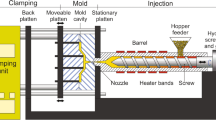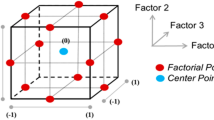Abstract
An accurate description of the metal flow behavior during wedge zone deformation is key to the stability of the endless strip production rolling process. To predict the flatness distribution based on the law of volume invariance, a flatness calculation model of the wedge zone during the flying gauge change (FGC) process was established by considering the metal transverse flow. Furthermore, the effect of different rolling parameters on the flow of metal in the wedge zone was investigated using a combination of this model with a 3D finite element model. In addition, the influences of the reduction rate, roll crown, and friction coefficient on the flatness and metal lateral flow were analyzed and discussed. Finally, the numerical results provided by the finite element model were compared with the computed results of the flatness distribution to illustrate the effectiveness and stability of the proposed model.


















Similar content being viewed by others
Change history
20 July 2023
A Correction to this paper has been published: https://doi.org/10.1007/s00170-023-11589-6
References
Arvedi G, Mazzolari F, Siegl J, Hohenbichler G, Holleis G (2010) Arvedi ESP first thin slab endless casting and rolling results. Ironmak Steelmak 37(4):271–275. https://doi.org/10.1179/030192310X12646889255744
Peng W, Chen XR, Zhang L, Li XD, Sun J, Zhang DH (2021) Finite element analysis of temperature uniformity in transverse induction heating process in ESP rolling. Int J Adv Manuf Tech 115(11):3423–3439. https://doi.org/10.1007/s00170-021-07386-8
Wang JS, Jiang ZY, Tieu AK, Liu XH, Wang GD (2007) A flying gauge change model in tandem cold strip mill. J Mater Process Tech 204(1–3):152–161. https://doi.org/10.1016/j.jmatprotec.2007.11.046
Baek JM, Kwon WK, Park JH, Han SH (2016) Control methodology for stabilized strip tracking in tandem cold strip mill system. 16th International Conference on Control, Automation and Systems (ICCAS), IEEE, pp 1192–1196
Zhang LJ, Deng HY, Yu W, Xu YD, Cheng ZS (2015) Simulation study of plate pre-straightening process based on finite element method. Metal Ind Autom 39(3):71–75. https://doi.org/10.3969/j.issn.1000-7059.2015.03.013
Li HB, Zhang J, Cao JG, Si XM, Zhang SS, Li YH (2008) Characteristics of profile control on CSP hot strip mill. J Cent South Univ 40(2):422–428.https://JournalArticle/5af16925c095d718d8e3459c
Su YP, Wang RZ, He AR, Yang Q, Shan J (2008) Research and application on shift compensation of LVC work roll contour. Metal Ind Autom 32(6):17–21. https:CNKI:SUN:YJZH.0.2008-06-007
Yao CH, He AR, Shao J, Zhao JW, Zhou GY, Li H, Qiang Y (2020) Finite difference modeling of the interstand evolutions of profile and residual stress during hot strip rolling. Metals-Basel 10(11):1417. https://doi.org/10.3390/met10111417
Jacques N, Elias A, Potier-Ferry M, Zahrouni H (2007) Buckling and wrinkling during strip conveying in processing lines. J Mater Process Technol 190(1–3):33–40. https://doi.org/10.1016/j.jmatprotec.2007.03.117
Li H, He AR, Shao J, Yao CH, Zheng J, Wang ER, Zhang ZH (2020) Numerical analysis on flatness adjusting performance of hot wide strip temper mill with small-diameter work rolls. Ironmak Steelmak 48(5):559–569. https://doi.org/10.1080/03019233.2020.1821591
Li LJ, Xie HB, Liu TW, Huo MS, Liu X, Li XS, Shi KX, Li JX, Liu HQ, Sun L, Jiang ZY (2022) Influence mechanism of rolling force on strip shape during tandem hot rolling using a novel 3D multi-stand coupled thermo-mechanical FE model. J Manuf Process 81:505–521. https://doi.org/10.1016/j.jmapro.2022.07.025
He HN, Shao J, Wang XC, Yang Q, Liu Y, Xu D, Sun YZ (2021) Research and application of approximate rectangular section control technology in hot strip mills. J Iron Steel Res Int 28(3):279–290. https://doi.org/10.1007/s42243-021-00558-6
Orowan E (1943) The calculation of roll pressure in hot and cold flat rolling. Proc I Mech Eng 150:140–167. https://doi.org/10.1243/pime_proc_1943_150_025_02
Bernsmann G (1972) Lateral material flow during cold rolling of strip. Iron Steel Eng 49:67–71
Zhao JW, Wang XC, Yang Q, Wang QN, Liu C, Song GY (2019) High precision shape model and presetting strategy for strip hot rolling. J Mater Process Tech 265:99–111. https://doi.org/10.1016/j.jmatprotec.2018.10.005
Allwood JM (2001) A hybrid 2.5 dimensional elastoviscoplastic model of hot strip rolling for practical applications. In: Simulation mater process: theory, methods and applications, pp. 519–525
Li CW, Wang XC, Yang Q, Wang LS (2013) Metal transverse flow and its influence factors of hot rolled strips. J Univ Sci Tech Beijing 35(2):222–227. https://doi.org/10.13374/j.issn1001-053x.2013.02.009
Moazeni B, Salimi M (2015) Investigations on relations between shape defects and thickness profile variations in thin flat rolling. Int J Adv Manuf Tech 77(5–8):1315–1331. https://doi.org/10.1007/s00170-014-6544-6
Dixon AE, Yuen WYD (2008) A physical based method to predict spread and shape during flat rolling for real-time application. Steel Res Int 79(4):287–296. https://doi.org/10.1002/srin.200806353
Ren ZK, Xiao H, Xie HB, Liu X (2018) Influence of lateral displacement on strip shape during cold rolling. J Iron Steel Res Int 25(9):892–900. https://doi.org/10.1007/s42243-018-0130-3
Chai XJ, Li HB, Zhang J, Zhou YZ, Ma HH, Zhang PW (2018) Flatness analysis and control of strips with different thickness in 2250 mm hot tandem rolling. Steel Res Int 89(12):1800404. https://doi.org/10.1002/srin.201800404
Yao CH, He AR, Shao J, Zhao JW (2019) A real-time quasi-3D metal flow model for hot strip rolling. Int J Mech Sci 159:91–102. https://doi.org/10.1016/j.ijmecsci.2019.05.045
Zhao JW, Wang XC, Yang Q, Wang QN, Wang YY, Li WP (2021) Mechanism of lateral metal flow on residual stress distribution during hot strip rolling. J Mater Process Tech 288:116838. https://doi.org/10.1016/j.jmatprotec.2020.116838
Wang QL, Sun J, Li X, Wang ZH, Wang PF, Zhang DH (2020) Analysis of lateral metal flow-induced flatness deviations of rolled steel strip: mathematical modeling and simulation experiments. Appl Math Model 77(Pt1):289–308. https://doi.org/10.1016/j.apm.2019.07.036
Kopp R, Böhlke P (2003) A new rolling process for strips with a defined cross section. CIRP Ann-Manuf Techn 52(1):197–200. https://doi.org/10.1016/S0007-8506(07)60564-2
Wang DC, Dong LC, Liu HM, Wang Y (2015) Velocity preset and transitional zone’s shape optimization for tailor rolled blank. J Iron Steel Res Int 22(4):279–287. https://doi.org/10.1016/S1006-706X(15)30001-7
Zhang GJ, Liu XH, Hu XL, Zhi Y (2013) Horizontal velocity of variable gauge rolling: theory and finite elements simulation. J Iron Steel Res Int 20(10):10–16. https://doi.org/10.1016/S1006-706X(13)60169-7
Shafiei E, Dehghani K (2018) Effects of deformation conditions on the rolling force during variable gauge rolling. J Manuf Mater Process 2(3):48. https://doi.org/10.3390/jmmp2030048
Weisz-Patrault D (2015) Inverse Cauchy method with conformal mapping: application to latent flatness defect detection during rolling process. Int J Solids Struct 56–57:175–193. https://doi.org/10.1016/j.ijsolstr.2014.11.017
Abdelkhalek S, Zahrouni H, Legrand N, Potier-Ferry M (2015) Post-buckling modeling for strips under tension and residual stresses using asymptotic numerical method. Int J Mech Sci 104:126–137. https://doi.org/10.1016/j.ijmecsci.2015.10.011
Liu GY, Yang Y, Tafti DK, Ye XS, Cao Z, Zhu DM (2020) Analysis of multiphase heat transfer of TA2/Q235B clad plate subjected to impinging liquid jet cooling. Heat Transf Eng 42(17):1473–1488. https://doi.org/10.1080/01457632.2020.1800273
Funding
This work was supported by the National Key R&D Program of China (2022YFB3304800) and the National Natural Science Foundation of China (U21A20117, 52074085).
Author information
Authors and Affiliations
Contributions
All authors contributed to the study conception and design. Material preparation, data collection, and analysis were performed by Wen Peng, Qinglong Wang, and Jie Sun. The first draft of the manuscript was written by Xi Chen and Zilong Wan; Dianhua Zhang provides important guidance on some of the issues that arise, and all authors commented on previous versions of the manuscript. All authors read and approved the final manuscript.
Corresponding authors
Ethics declarations
Competing interests
The authors declare no competing interests.
Additional information
Publisher's Note
Springer Nature remains neutral with regard to jurisdictional claims in published maps and institutional affiliations.
The original online version of this article was revised: Figure 15a has been inserted
Rights and permissions
Springer Nature or its licensor (e.g. a society or other partner) holds exclusive rights to this article under a publishing agreement with the author(s) or other rightsholder(s); author self-archiving of the accepted manuscript version of this article is solely governed by the terms of such publishing agreement and applicable law.
About this article
Cite this article
Peng, W., Chen, X., Wang, Q. et al. Mathematical modeling and simulated analysis of metal flow behavior during the FGC of ESP rolling process. Int J Adv Manuf Technol 127, 5031–5047 (2023). https://doi.org/10.1007/s00170-023-11449-3
Received:
Accepted:
Published:
Issue Date:
DOI: https://doi.org/10.1007/s00170-023-11449-3




